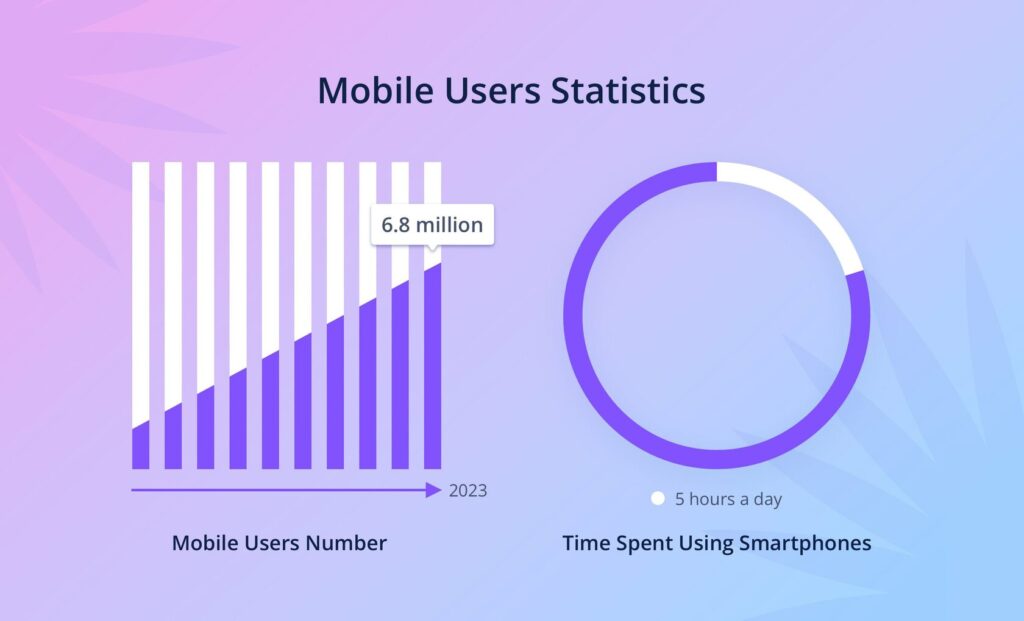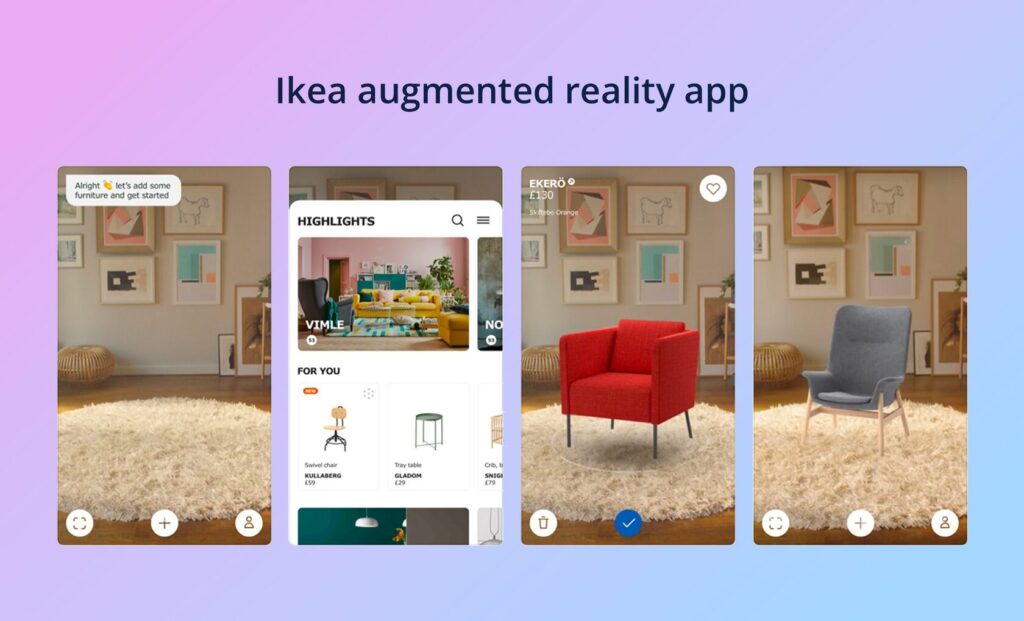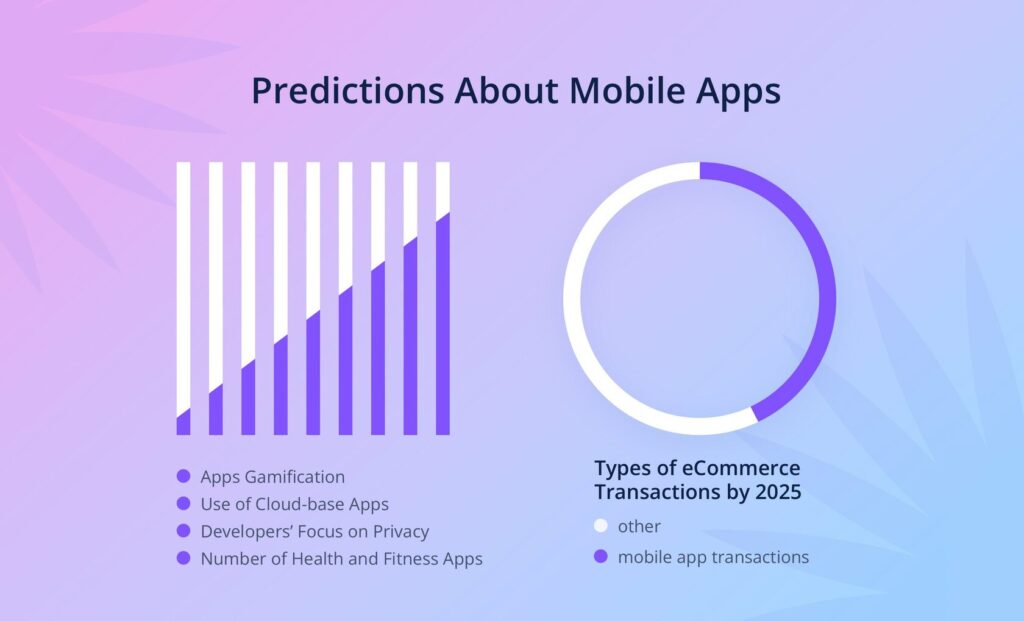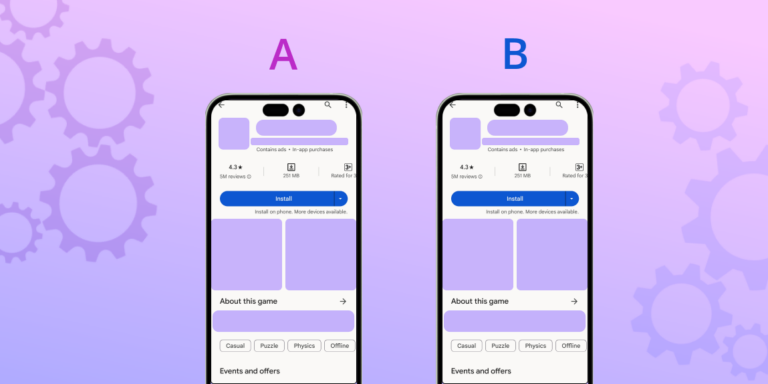We live in the era of the so-called “mobile-first” world when the vast majority of brands and companies create products that prioritize mobile over desktop users. It is not surprising because experts’ forecasts show that the number of mobile users continues to grow steadily, and it will exceed 6.8 million in 2023. Why is it vital to follow the latest app trends?
With the continued demand for mobile products, you’ll probably want your piece of the pie. Dealing with competition is not easy, so you need to be aware of the current app industry trends to offer your audience what they really need. Our experts have analyzed and picked out ten directions that will be relevant in mobile development this year. This article explains how these trends affect the industry as a whole and what problems you can solve using them.
According to statistics, modern users spend about 5 hours a day on smartphones. Knowing which trends are in demand right now, you can offer them what they want to spend most of their time on. It will increase your popularity, installs, and income.

- Rise of Augmented Reality Apps
Considering the constant growth of competition in the virtual space, you should be able to build a business that can reach the maximum number of customers. Augmented reality technology solves this problem by taking the user experience to a new level.
Thanks to AR, you can try on clothes before you buy stuff, edit photos and videos (like on iOS 16), apply fantasy filters on TikTok, and even plan furniture arrangements with the IKEA app. Among the latest app trends, AR occupies one of the first places.
Developers have managed to make this technology easier and more accessible; although, nowadays, the mobile device possibilities for the application of AR are still somewhat limited. Still, many people expect the best applications to have this feature.
- AR makes shopping more accessible and convenient.
- It opens up new possibilities in photo and video editing.
- The AR mobile app market size will reach $36 billion by 2026.

- Increased Use of Artificial Intelligence
Artificial intelligence is the future of mobile apps because:
- It solves the problem of analyzing large amounts of data, identifying patterns, and finding errors where human capabilities are limited.
- It improves the overall efficiency of development and production.
These features are actively used in various areas: from the restaurant business to healthcare and IoT ecosystems. For example, McDonald’s uses AI to analyze demand and personalize customer menus. In the healthcare industry, AI is being used for big data analysis. At the same time, the main problem of AI is the lack of emotional intelligence and the need to consume large amounts of information for learning and work, which might go against data safety regulations.
- AI allows you to process large amounts of data faster.
- It helps to personalize the user experience.
- It makes it easier to spot errors and patterns.
- Emergence of Blockchain Apps
The need to protect personal data is now more acute than ever since a huge amount of information is stored electronically. Because of it, there is a high risk of hacking and theft. Blockchain technologies in mobile apps provide users with the highest level of application security management.
While they are most prevalent in finance and banking, these app market trends have now made their way into retail, real estate, energy, and entertainment spheres. For example, the Sony Music department in Japan uses this technology to protect copyrights.
Among the trend limitations, we’d like to note its novelty and some “immaturity.” It leads to some issues, for instance, with scalability. For comparison, Ethereum (based on this technology) processes 20 transactions per second, while the more common Visa — about 24000 tps.
- Blockchain technology makes any mobile business more secure.
- It enhances information protection while maintaining transparency.
- It minimizes the possibility of hacking and theft of sensitive data.
- Integration of Virtual Assistants
While virtual assistants can be useful for everyone, they are vital for vulnerable groups of users. By incorporating these features into your mobile products, you can make them more accessible to people with disabilities of different levels, which allows you to expand your target audience in the mobile application market.
Virtual assistants (such as Siri, Google Assistant, and Alexa) help individuals and businesses streamline their daily and work tasks. They can find relevant information, answer complex queries, and make recommendations about complex problems. This technology is developing along with AI and ML, so its capabilities are highly dependent on these two areas.
- Improved customer service and user experience.
- Virtual assistants make mobile apps accessible.
- Such technologies increase the profitability of production.
- Increased Use of Chatbots
How to make customer service 24/7 without hiring additional staff? The answer is chatbots. Although virtual assistants remain in demand and are urgently needed in some situations, last year’s statistics show that about 40% of users prefer chatbots.
The development of AI and ML technologies makes interaction with them more natural. Chatbots improve the quality of customer service and reduce costs by automating routine processes. Although interaction with these “virtual assistants” becomes more natural every year, they can still make mistakes, which can be critical in certain areas.
- AI-enabled chatbots contribute to the automation of business processes.
- They improve customer support and provide a better user experience.
- The chatbot app market share is showing steady growth, with a projected value of over $1.2 billion by 2025.
- Growth of Mobile Commerce
Today’s consumers prefer shopping through mobile apps instead of wandering in malls. If you have a retail business and have not created your app yet, you should do it now so as not to lose most of the audience. Sales of goods and services using mobile devices by 2025 will likely be about 44% of eCommerce transactions. People use apps not only for direct purchases but also for finding the best deals, comparing prices and reviews, etc.
This format makes the buying process available anywhere and, in combination with AR, even more convenient. Read about other popular categories in our article “What Types of Apps Are Most Popular Right Now”. Purchasing through mobile apps might come with some risks such as banking data theft, so you should also keep an eye on current trends in protecting customer information.
- Retail stores engage mobile shoppers as their percentage is steadily increasing.
- Compared to traditional shopping, mCommerce offers an advanced customer experience.

- Continued Expansion of Gaming Apps
Games are the most popular category in digital stores. The main task of such products is to entertain users. For developers, gamers are a fertile audience always open to something new. The popularity of mobile games has led to a trend toward the gamification of non-gaming apps. The most notable examples of such products are Duolingo, Habitika, and Yousician. Gamification has proven to be effective in increasing revenues (up to 95% in some cases) and retention rates (around 5%).
Game elements are found in learning, shopping, fitness, reading, task managing, and other apps. See our “Mobile Gaming Industry Trends & Growth Prospects” article for more gaming trends and mechanics. The main problem in mobile game development is incredibly high competition, which can be overcome only by building a winning ASO and offering customers something unique.
- Games gained popularity in the wake of the pandemic but continue to maintain it to this day.
- Elements of gamification appear in non-gaming apps of different categories.
- Increased Focus on User Privacy
The proliferation of real-time transactions leads to increased fraud through mobile apps. According to Gartner’s mobile app industry analysis, by 2024, about 75% of the entire population will have their data protected by various privacy regulations.
This trend forces businesses to improve their systems for collecting, processing, and storing user information. Besides, mobile users want more control over their data. The difficulty in using data-driven services is related to this trend, which is why limited developers are forced to adjust their audience analysis tools.
- Mobile apps have become more reliable in terms of information storage.
- Users get more control over their data.
- Data-driven app developers have to be more creative.
- Continued Development of Health and Fitness Apps
The pandemic and lockdowns have given impetus to the development of healthcare and fitness products. Back then, users were deprived of the usual format of sports activity, though by now, these assistant apps have firmly entered everyday life.
A good example is the app stats about Fitbit’s growing revenue, which passed the $2 million mark on Google Play alone in September 2022. Other top products include Strava, MyFitnessPal, and Calm. The functionality of healthcare and fitness applications is limited by the capabilities of users’ mobile and wearable devices. To capture the audience’s attention, you have to revise the usual experience.
- Fitness apps offer a unique user experience with gamification.
- They use the capabilities of smartphones and wearable devices.
- They help monitor a variety of health indicators.
- Greater Use of Cloud-Based Apps
Cloud services solve the problem of storing and exchanging large amounts of data, documents, and media files for businesses and private users. They cannot be called the fastest-growing mobile apps, as they are highly specialized and not for entertainment. However, such technologies have become integral to many industries and businesses. Not only will their distribution continue but also their improvement.
Edge computing is considered to be an advanced stage of clouds. It significantly speeds up data exchange. With the development of 5G technology, it has become even more in demand, for example, in the IoT and autonomous car industries. However, cloud technologies are associated with the risk of theft of stored data and local restrictions that governments can impose on the use of such services.
- Cloud apps provide remote data storage and access to them from anywhere.
- Advanced edge computing technologies reduce network response latency and use bandwidth efficiently.
Keep Up With Mobile App Trends
The main worldwide trend now is the transition from desktop versions of services to mobile ones. It was affected both by the pandemic and the global development of technology. They have changed the way we think about and interact with mobile apps and made consumers more dependent on them. That is why developers introduce new tools and features into their products to bring the user experience to a whole new level.
Artificial intelligence, machine learning, augmented reality, a high degree of data protection, cloud and edge computing, and much more make mobile apps indispensable assistants for both everyday and business tasks. Given the constantly growing competition and high user demand, lagging behind modern trends can have an extremely negative impact on your app promotion. Use this article to understand how to improve your development to keep up with the times and sustain your audience’s interest.




